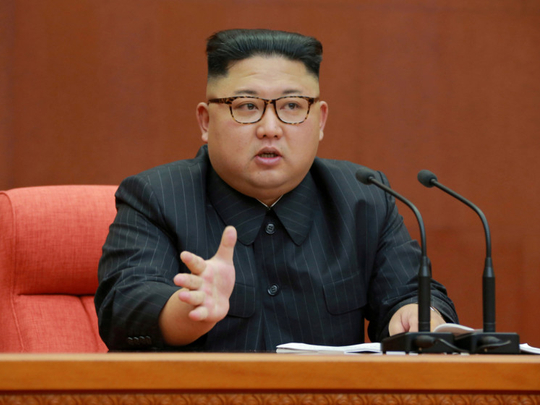
On just the first day of a war between the United States and North Korea, according to a Stanford University assessment, 1 million people could be killed.
Such a nuclear war seems terrifyingly imaginable. In the North Korean capital, Pyongyang, it is clear that US President Donald Trump’s threat to “totally destroy” North Korea has backfired and is being exploited by Kim Jong-un for his own propaganda and military mobilisation.
The country has seized on Trump’s words to reinforce its official narrative that its nuclear arsenal is defensive, meant to protect Koreans from bullying American imperialists. And North Korean officials use Trump’s bombast as an excuse for their own. “The American Trump uttered nonsense about demolishing our country,” a military officer, Lt Col Hwang Myon Jin told me in North Korea. “So as soon as our supreme leader gives us an order, we will turn the entire country of the US into fire.” One typical propaganda image shows a powerful North Korean soldier stepping on the face of an evil-looking blond US soldier and reads, “Death to invaders”.
Kim doesn’t want to appear weak and seem as if he is caving in to US pressure, and officials in North Korea repeatedly cited Trump’s threats to justify their military mobilisation and their reluctance to engage in dialogue or conciliation. “The current Trump administration’s aggressive remarks about how he can totally destroy my country make it unthinkable that we can start any dialogue,” said Ri Yong Pil, a senior Foreign Ministry official.
My recent visit to the Korean peninsula left me thinking that Trump’s entire strategy rests on a series of fundamental and dangerous misconceptions.
The first misconception is that sanctions and talk of war will lead North Korea to give up its nuclear weapons. Every North Korean official we spoke to insisted that this was impossible, and the US intelligence community likewise believes that this just won’t happen, for (as I mentioned in my last column) North Korea sees nuclear warheads as crucial to its survival.
We did see signs that sanctions are biting, for businessmen complained about China cracking down on trade; gas prices have doubled; and electricity is rationed. Power outages are routine even in the capital. Yet, solar panels are becoming more common, and Kim has moved to liberalise the economy in ways that generate growth despite sanctions. Collective farms are allowing greater use of private plots, factory managers enjoy more responsibility to turn profits and street markets are more tolerated than before.
The bite of sanctions on elites is also dulled by a Kim initiative to inject a bit of fun into life in the capital (special permission is needed for North Koreans to visit Pyongyang, let alone live there). This is still the most totalitarian country in the world, but it does have an amusement park, a water park, a ski area and a dolphin show — North Korea’s version of SeaWorld. Economic reforms helped generate gross domestic product growth, after long stagnation, of 3.9 per cent last year, according to South Korea’s central bank. That’s more than twice the growth rate last year in the US of 1.6 per cent.
The second US misconception is that China can transform North Korean behaviour. We’ve always exaggerated Chinese influence on North Korea. Kim has gone out of his way to humiliate Chinese President Xi Jinping, and Chinese officials fear that this will happen again this month with a missile launch or nuclear test during China’s 19th Communist Party Congress. North Korea has refused even to allow a visit by the Chinese point man for North Korean affairs, Kong Xuanyou. “We know what Kong would say, so he doesn’t need to say it here,” one North Korean official told me scornfully.
The third US misconception is the assumption that the North Korean regime is near collapse, and that huffing and puffing will accelerate this. In the early 1990s, my wife and I chose to be Tokyo correspondents for the Times partly because that would enable us to cover North Korea — and its impending collapse. We’re still waiting. Yes, at some point it’ll happen, but don’t count on it tomorrow. And the economic reforms, however modest, may give the regime a bit more life. Trump has genuinely increased the economic pressure on North Korea through United Nations sanctions, and the pinch may increase. But one of the worst mistakes in international relations, plaguing America from Vietnam to Iraq, is to operate on wishful thinking rather than reality, and I fear that’s what’s happening here in a perilous way.
To be blunt, Trump’s strategy frightens me. In speech and through Twitter, he is escalating a conflict and trumpeting military options as he insists on a goal of denuclearisation that is unachievable, a tactic of Chinese pressure that is unrealistic and a premise of regime fragility that is wishful thinking.
That’s how wars happen.
— New York Times News Service
Nicholas Kristof is an American journalist, author and a winner of two Pulitzer Prizes.










